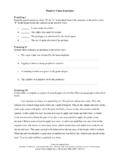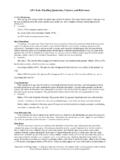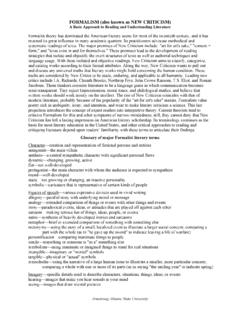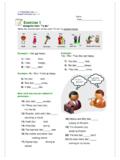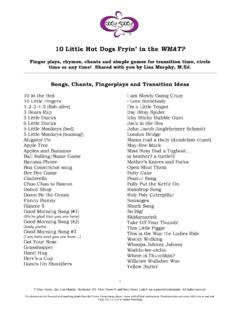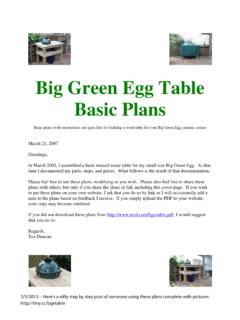Transcription of Seven Types of Paragraph Development - Armstrong …
1 Seven Types of Paragraph Development Annotated examples of narration, exposition, definition, description, comparison, process analysis, and persuasion by Gerald Grow, PhD Division of Journalism Florida A&M University 1999. May be used by teachers for nonprofit educational use. May not be reprinted elsewhere without permission. Available at: In their pursuit of clear, concise writing, journalism students sometimes develop the habit of writing everything in short, choppy paragraphs that are unrelated to one another. Reviewing any good high school writing handbook will remind you that considerable thought has been given to how longer paragraphs can be developed into well focused presentations of single units of thought. What follows is an (imaginary) article invented to illustrate many of the "modes of discourse"--the traditional methods by which writing is developed. In succession, the following paragraphs are narration, exposition, definition, classification, description, process analysis, and persuasion.
2 (The process analysis Paragraph has been broken into a bulleted list, in typical "how to" style.) In most writing, these modes are mixed in natural combinations; for example, narration frequently includes description. The following paragraphs have been devised in an attempt to emphasize the characteristics of each mode of writing. The result is somewhat artificial--you would not normally write an article containing one each of Seven Types of paragraphs !--but I hope it is more memorable than a series of unrelated illustrations. Narration Around 2 something woke Charles Hanson up. He lay in the dark listening. Something felt wrong. Outside, crickets sang, tree-frogs chirruped. Across the distant forest floated two muffled hoots from a barred owl. It was too quiet. At home in New Jersey, the nights are filled with the busy, comforting sounds of traffic. You always have the comforting knowledge that other people are all around you.
3 And light: At home he can read in bed by the glow of the streetlight. It was too quiet. And much too dark. Even starlight failed to penetrate the 80-foot canopy of trees the camper was parked beneath. It was the darkest dark he had ever seen. He felt for the flashlight beside his bunk. It was gone. He found where his pants were hanging and, as he felt the pockets for a box of matches, something rustled in the leaves right outside the window, inches from his face. He heard his wife, Wanda, hold her breath; she was awake, too. Then, whatever, was outside in the darkness also breathed, and the huge silence of the night seemed to come inside the camper, stifling them. It was then he decided to pack up and move to a motel. Comments on narration: Normally chronological (though sometimes uses flashbacks) A sequential presentation of the events that add up to a story. A narrative differs from a mere listing of events. Narration usually contains characters, a setting, a conflict, and a resolution.
4 Time and place and person are normally established. In this Paragraph , the "story" components are: a protagonist (Hanson), a setting (the park), a goal (to camp), an obstacle (nature), a climax (his panic), and a resolution (leaving). Specific details always help a story, but so does interpretive language. You don't just lay the words on the page; you point them in the direction of a story. This narrative serves as the opening anecdote that illustrates the topic of the story Exposition This family was a victim of a problem they could have avoided-a problem that, according to Florida park rangers, hundreds of visitors suffer each year. "Several times a month," ranger Rod Torres of O'Leno State Park said, "people get scared and leave the park in the middle of the night." Those people picked the wrong kind of park to visit. Not that there was anything wrong Seven Types of Paragraph Development Annotated examples of narration, exposition, definition, description, comparison, process analysis, and persuasion by Gerald Grow, PhD Division of Journalism Florida A&M University 1999.
5 May be used by teachers for nonprofit educational use. May not be reprinted elsewhere without permission. Available at: with the park: The hikers camped next to them loved the wild isolation of it. But it just wasn't the kind of place the couple from New Jersey had in mind when they decided to camp out on this trip through Florida. If they had known about the different kinds of parks in Florida, they might have stayed in a place they loved. Comments on exposition: Exposition is explanatory writing Exposition can be an incidental part of a description or a narration, or it can be the heart of an article Aside from clarity, the key problem with exposition is credibility. What makes your explanation believable? Normally, writers solve this problem by citing authorities who have good credentials and good reason to be experts in the subject. This Paragraph also happens to serve as the justifier or "nut graf" for the little article: the Paragraph that, after an indirect opening, specifies the topic of the article, why it is important, and what is to come.
6 Definition "Park" is difficult to define in Florida, because there are so many kinds of parks. Basically, a park is a place to go for outdoor recreation-to swim, picnic, hike, camp, walk the dog, play tennis, paddle your canoe, and, in some places take rides in miniature trains or swish down a waterslide. Florida has a rich variety of parks, ranging from acres of RVs ringed around recreation halls, to impenetrable mangrove wilderness. To make things more complicated, not all of them are called "parks," and even the ones called "parks" come in several varieties. Comments on definition: Never define anything by the "according to Webster's" method. Meaning is found in the world, not in the dictionary. Bring the world into your story and use it to define your terms. Saying what something is NOT can help readers; but make a strong effort to say what it IS. Description O'Leno is a good example of a state park in Florida.
7 Surrounded by the tall, shaded woods of a beautiful hardwood forest, the Santa Fe River disappears in a large, slowly swirling, tree-lined pool. After appearing intermittently in scattered sinkholes, the river rises three miles downstream in a big boil, then continues on to meet the Suwannee and the sea. Nearby, stands of cypress mirror themselves in the still waters, walls of dense river swamp rise before you, sudden sinkholes open in the woodlands-rich with cool ferns and mosses. Farther from the river, expanses of longleaf pinelands stretch across rolling hills. In the midst of this lovely setting, you find 65 campsites, 18 rustic cabins, and a pavilion for group meetings. A diving platform marks a good place to swim in the soft, cool waters of the Santa Fe, and canoeing up this dark river is like traveling backwards in time in the direction of original Florida. Comments on description: Description is not what you saw, but what readers need to see in order to imagine the scene, person, object, etc.
8 Description requires you to record a series of detailed observations. Be especially careful to make real observations. The success of a description lies in the difference between what a reader can imagine and what you actually saw and recorded; from that gap arises a spark of engagement. Use sensory language. Go light on adjectives and adverbs. Look for ways to describe action. Pay special attention to the sound and rhythm of words; use these when you can. Seven Types of Paragraph Development Annotated examples of narration, exposition, definition, description, comparison, process analysis, and persuasion by Gerald Grow, PhD Division of Journalism Florida A&M University 1999. May be used by teachers for nonprofit educational use. May not be reprinted elsewhere without permission. Available at: Think that your language is not so much describing a thing as describing a frame around the thing--a frame so vivid that your reader can pour his or her imagination into it and "see" the thing--even though you never showed it.
9 Portray. Also evoke. The key problem in description is to avoid being static or flat. Adopt a strategy that makes your description into a little story: move from far to near, left to right, old to new, or, as in this example, down a river, to give your description a natural of description as a little narrative in which the visual characteristics unfold in a natural, interesting, dramatic order. Think of what pieces readers need, in what order, to construct a scene. Try making the description a little dramatic revelation, like watching an actor put on a costume--where you cannot decipher what the costume means until many of the parts are in place. Never tease readers or withhold descriptive detail, unless for some strange reason that is the nature of your writing. Lay it out. Give your description away as generously as the world gives away sights. Let it show as transparently as seeing. The cognitive difficulty in description is simple: People see all-at-once.
10 But they read sequentially, one-part-at-the-time, in a series of pieces. Choose the pieces. Sequence them so they add up. Think: Readers first read this, now this, now this; what do they need next? Remember, you never just describe something: The description is always part of a larger point. Use the description to make your point, or to move your story along. Comparison Forest and river dominate O'Leno State Park. By contrast, Lloyd Beach State Recreation Area, near Fort Lauderdale, is dominated by the oily bodies of sun-worshippers who crowd into it every summer weekend. Where O'Leno gives you so much quiet you can hear the leaves whispering, Lloyd Beach is a place of boisterous activity. You can walk a few yards in O'Leno and pass beyond every sign of human civilization. When you walk at Lloyd Beach, you have to be careful to step over the picnic baskets, umbrellas, jam boxes, and browning bodies. At night, O'Leno wraps itself with the silence of crickets and owls.
